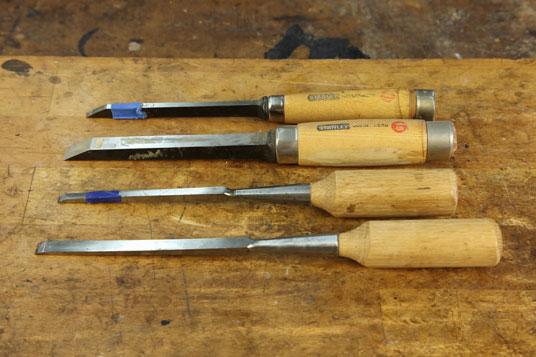Are you wondering whether you need a mortise chisel for your woodworking projects? Well, let’s dive in and find out!
If you’re someone who loves working with wood, a mortise chisel might just become your new best friend.
In this article, we’ll explore what a mortise chisel is, how it is used, and whether it’s an essential tool for your woodworking endeavors. So, let’s get started and discover if a mortise chisel is a must-have in your toolbox!
When it comes to woodworking, having the right tools is essential. While a mortise chisel can be a valuable addition to your toolkit, whether you need one depends on the type of projects you undertake. Mortise chisels are specifically designed for creating square holes and joints. If you frequently work with joints and need precise, clean cuts, a mortise chisel would be a great investment. However, if you primarily work with different joinery techniques or prefer alternative tools, a mortise chisel may not be necessary.

Do I Need a Mortise Chisel?
When it comes to woodworking, having the right tools is essential. One tool that often comes up in discussions is the mortise chisel. But what exactly is a mortise chisel, and do you really need one? In this article, we’ll delve into the world of mortise chisels, exploring their uses, benefits, and whether or not they are a necessary addition to your toolkit.
Understanding Mortise Chisels
A mortise chisel is a specialized woodworking tool used to create rectangular holes or slots, known as mortises, in wooden pieces. These chisels typically have a thicker, wider blade than regular bench chisels, allowing them to remove larger amounts of material with each strike.
The primary purpose of a mortise chisel is to create mortises that will eventually house other woodworking components, such as tenons or hinges. By using a mortise chisel, woodworkers can achieve clean and precise mortises, ensuring a strong and secure joint.
While a mortise chisel is primarily used for making mortises, it can also be handy for various other tasks, such as cleaning up corners, shaping wood, or trimming tenons. However, for these secondary tasks, a regular bench chisel may suffice, depending on your project requirements.
The Benefits of Using a Mortise Chisel
There are several benefits to using a mortise chisel in your woodworking projects. First and foremost, a mortise chisel allows you to create sturdy and tight-fitting mortise-and-tenon joints. This type of joinery is known for its strength and longevity, making it a popular choice for furniture making and other woodworking applications.
In addition to the strength it provides, a mortise chisel also offers greater precision and control compared to other tools. The wide, flat blade allows for accurate removal of material, ensuring a snug fit for the tenon and minimizing the need for excessive sanding or filing. This precision is especially crucial for intricate projects or when working with expensive or valuable wood.
Furthermore, using a mortise chisel can save you time and effort. The larger blade size enables you to remove more material with each strike, making the mortising process faster than when using a smaller chisel. This efficiency can be significant, especially if you have multiple mortises to create or if you are working on a time-sensitive project.
Tips for Choosing and Using a Mortise Chisel
Now that you understand the benefits of using a mortise chisel, here are a few tips to help you choose and use one effectively:
- Invest in a high-quality mortise chisel. Look for one made from durable materials, such as high-carbon steel, with a well-finished blade that holds its edge.
- Consider the size and width of the chisel blade. Choose a size that corresponds to the dimensions of your workpieces to ensure a proper fit.
- Keep your mortise chisel sharp at all times. A dull chisel can lead to inaccurate and messy mortises.
- Pair your mortise chisel with a sturdy mallet or hammer. Avoid using excessive force when striking the chisel, as this can damage both the chisel and the workpiece.
- Practice proper technique and control. Start with small, controlled strikes and gradually increase the force as needed. Take your time to ensure clean and accurate mortises.
Common Questions About Mortise Chisels
As you explore the world of mortise chisels, you may come across some common questions. Here are a few of them, along with their answers:
Can I use a regular chisel instead of a mortise chisel?
While it is possible to use a regular bench chisel for simple mortising tasks, a mortise chisel is specifically designed for this purpose and offers better control, precision, and efficiency.
What is the difference between a mortise chisel and a carving chisel?
A mortise chisel is used for creating square or rectangular holes, while a carving chisel is used for shaping and sculpting wood. The two chisels have different blade shapes and are used for distinct woodworking tasks.
Do I need different-sized mortise chisels?
The size of the mortise chisel you need will depend on the dimensions of your workpieces and the specific project requirements. Having a few different sizes on hand can be beneficial for versatility and accommodating various needs.
What Projects Can I Use a Mortise Chisel For?
Now that you know more about mortise chisels and their benefits, let’s explore some common woodworking projects where using a mortise chisel is advantageous:
Making Furniture
Whether you are creating a traditional dining table, a wooden chair, or a custom cabinet, mortise chisels are indispensable for creating strong and durable joints. Mortise-and-tenon joinery is widely used in furniture making, providing stability and longevity to the finished pieces.
Building Doors and Windows
Doors and windows require precise joinery to ensure proper functionality and long-lasting performance. Utilizing mortise chisels allows you to create clean mortises for hinges, locks, and other hardware, resulting in smooth-opening doors and windows that fit perfectly into their frames.
Crafting Instruments
For musicians, utilizing mortise chisels is crucial when crafting instruments such as guitars, violins, and woodwinds. The precise and secure joinery provided by mortise-and-tenon joints ensures optimal sound quality and structural integrity in these intricate musical instruments.
Overall, whether you are a professional woodworker or a hobbyist, having a mortise chisel in your tool collection can greatly enhance your woodworking projects. With its ability to create sturdy joints, provide precision and control, and save time and effort, a mortise chisel is indeed a valuable tool for any woodworking enthusiast.
Key Takeaways: Do I Need a Mortise Chisel?
- A mortise chisel is a specialized tool used for woodworking.
- You need a mortise chisel if you plan to create mortise and tenon joints.
- It helps you carve out a precise and clean recess for the tenon.
- Mortise chisels come in various sizes, so choose one that suits your woodworking projects.
- Investing in a good-quality mortise chisel can make your woodworking tasks easier and more accurate.
Frequently Asked Questions
When it comes to woodworking, having the right tools is essential. One tool that often comes up in discussions is the mortise chisel. Here, we answer some common questions related to the need for a mortise chisel.
1. What is a mortise chisel used for?
A mortise chisel is a specialized woodworking tool used for making rectangular slots or holes, known as mortises. These mortises are typically made to join pieces of wood together, such as when constructing furniture or frames. The chisel is designed to remove wood material in a clean and precise manner, allowing for a snug fit when inserting the tenon, which is the piece of wood that fits into the mortise.
Mortise chisels have a thick, sturdy blade and a long handle, providing leverage and control when working on tough wood. The sharp cutting edge of the chisel is specifically designed to remove waste material and shape the mortise with accuracy.
2. Can I use other tools instead of a mortise chisel?
While there are alternative methods and tools you can use to create mortises, a mortise chisel is specifically designed for this task and offers several advantages. Other tools, like drill bits or chisels, may not provide the level of precision and control that a mortise chisel offers.
Mortise chisels are specifically shaped and sharpened to remove wood efficiently and accurately. They have a square cross-section that matches the shape of the mortise, allowing for clean and precise cuts. Additionally, the length and weight of a mortise chisel give you better control over the depth and direction of your cuts.
3. Do I need a mortise chisel as a beginner woodworker?
As a beginner, you may not immediately need a mortise chisel if you’re starting with simple projects or using alternative joinery methods. However, if you plan to progress in your woodworking skills and tackle more advanced projects, investing in a mortise chisel can greatly expand your capabilities.
Mortise and tenon joints are commonly used in furniture-making and other woodworking projects, and having the right tools, including a mortise chisel, will allow you to create stronger and more durable joints. It’s worth considering adding a mortise chisel to your collection as you gain experience and take on more complex woodworking projects.
4. What sizes of mortise chisels should I consider?
Mortise chisels come in various sizes, and the one you choose depends on the scale of your projects and personal preference. Common sizes range from 1/4 inch to 1 inch wide. If you primarily work on larger projects, you may opt for broader chisels, while smaller projects may require narrower ones.
It’s also beneficial to have multiple sizes of mortise chisels in your toolkit, as they allow for versatility and flexibility when creating different-sized mortises. This way, you can choose the appropriate chisel based on the specific requirements of your project.
5. How do I maintain and sharpen a mortise chisel?
Maintaining and sharpening your mortise chisel is crucial to achieve clean and accurate cuts. Regularly inspect the chisel for any chips, cracks, or dullness. If you notice any issues, address them promptly to ensure optimal performance.
To sharpen a mortise chisel, you’ll need a sharpening stone or a honing guide. Follow the manufacturer’s instructions for sharpening angles and techniques. Make sure to maintain a sharp cutting edge while removing any burrs or imperfections from the blade. Properly caring for your mortise chisel will extend its lifespan and keep it in optimal working condition.

Why you should try mortising by hand
Summary
So, should you get a mortise chisel? Well, it depends on what you’re working on. If you’re doing a lot of woodworking projects that involve joints, then a mortise chisel can be really helpful. It’s designed specifically for creating clean and precise mortises, which are the slots that fit together with tenons to create strong joints.
However, if you’re not planning on doing a lot of joint work, then you may not need a mortise chisel. There are other chisels and tools that can still get the job done, albeit with a bit more effort and potentially less precision. Ultimately, it’s up to you and what kind of projects you enjoy working on. Just remember to practice proper safety and technique when using any chisel or tool.
